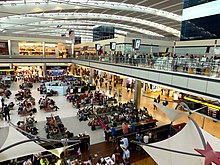uppermost point of a tree lightning protection system.
This article's lead section contains information that is not included elsewhere in the article. (August 2022) |
An airport terminal is a building at an airport where passengers transfer between ground transportation and the facilities that allow them to board and disembark from an aircraft.



Within the terminal; passengers purchase tickets; transfer their luggage; go through security. The buildings that provide access to the airplanes (via gates) are typically called concourses. However, the terms "terminal" and "concourse" are sometimes used interchangeably, depending on the configuration of the airport.
Smaller airports have one terminal while larger airports have several terminals and/or concourses. At small airports, the single terminal building typically serves all of the functions of a terminal and a concourse.
Some larger airports have one terminal that is connected to multiple concourses via walkways, sky-bridges, or tunnels (such as Denver International Airport, modeled after Atlanta's, the world's busiest), or Orlando International Airport (modeled after Tampa's). Some larger airports have more than one terminal, each with one or more concourses (such as New York's John F. Kennedy International Airport, which has five, and London's Heathrow Airport and Chicago's O'Hare International Airport, which both have four). Still other larger airports have multiple terminals each of which incorporate the functions of a concourse (such as Dallas/Fort Worth International Airport or Philadelphia International Airport).
According to Frommers, "most airport terminals are built in a plain style, with the concrete boxes of the 1960s and 1970s generally gave way to glass boxes in the 1990s and 2000s, with the best terminals making a vague stab at incorporating ideas of "light" and "air"'. However, some, such as Baghdad International Airport and Denver International Airport, are monumental in stature, while others are considered architectural masterpieces, such as Terminal 1 at Charles de Gaulle Airport, near Paris, the main terminal at Washington Dulles in Virginia, or the TWA Flight Center at New York's JFK Airport. A few are designed to reflect the culture of a particular area, some examples being the terminal at Albuquerque International Sunport in New Mexico, which is designed in the Pueblo Revival style popularized by architect John Gaw Meem, as well as the terminal at Bahías de Huatulco International Airport in Huatulco, Oaxaca, Mexico, which features some palapas that are interconnected to form the airport terminal."
When London Stansted Airport's new terminal opened in 1991, it marked a shift in airport terminal design since Norman Foster placed the baggage handling system in the basement in order to create a vast open interior space. Airport architects have followed this model since unobstructed sightlines aid with passenger orientation. In some cases, architects design the terminal's ceiling and flooring with cues that suggest the required directional flow. For instance, at Toronto Pearson's Terminal 1 Moshe Safdie included skylights for wayfinding purposes.


